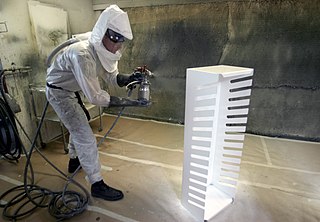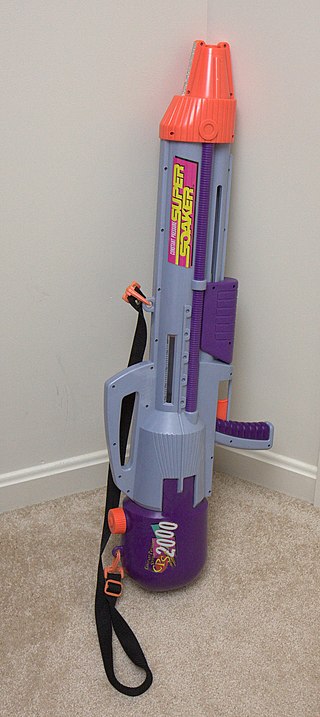
An air gun or airgun is a gun that uses energy from compressed air or other gases that are mechanically pressurized and then released to propel and accelerate projectiles, similar to the principle of the primitive blowgun. This is in contrast to a firearm, which shoots projectiles using energy generated via exothermic combustion (deflagration) of chemical propellants, most often black powder or smokeless powder.
Toy guns are toys which imitate real guns, but are designed for recreational sport or casual play by children. From hand-carved wooden replicas to factory-produced pop guns and cap guns, toy guns come in all sizes, prices and materials such as wood, metal, plastic or any combination thereof. Many newer toy guns are brightly colored and oddly shaped to prevent them from being mistaken for real firearms.

Spray painting is a painting technique in which a device sprays coating material through the air onto a surface. The most common types employ compressed gas—usually air—to atomize and direct the paint particles.

Aerosol spray is a type of dispensing system which creates an aerosol mist of liquid particles. It comprises a can or bottle that contains a payload, and a propellant under pressure. When the container's valve is opened, the payload is forced out of a small opening and emerges as an aerosol or mist.
A hydraulic accumulator is a pressure storage reservoir in which an incompressible hydraulic fluid is held under pressure that is applied by an external source of mechanical energy. The external source can be an engine, a spring, a raised weight, or a compressed gas. An accumulator enables a hydraulic system to cope with extremes of demand using a less powerful pump, to respond more quickly to a temporary demand, and to smooth out pulsations. It is a type of energy storage device.
A gas lift or bubble pump is a type of pump that can raise fluid between elevations by introducing gas bubbles into a vertical outlet tube; as the bubbles rise within the tube they cause a drop in the hydrostatic pressure behind them, causing the fluid to be pulled up. Gas lifts are commonly used as artificial lifts for water or oil, using compressed air or water vapor.

Super Soaker is an American brand of recreational water gun that uses manually-pressurized air to shoot water with greater power, range, and accuracy than conventional squirt pistols. The Super Soaker was invented in 1989 by engineer Lonnie Johnson. The prototype combined PVC pipe, acrylic glass, and an empty plastic soda bottle.
This is a glossary of firefighting equipment.

Snowmaking is the production of snow by forcing water and pressurized air through a "snow gun", also known as a "snow cannon". Snowmaking is mainly used at ski resorts to supplement natural snow. This allows ski resorts to improve the reliability of their snow cover and to extend their ski seasons from late autumn to early spring. Indoor ski slopes use snowmaking. They can generally do so year-round as they have climate-controlled environments.

An air pump is a pump for pushing air. Examples include a bicycle pump, pumps that are used to aerate an aquarium or a pond via an airstone; a gas compressor used to power a pneumatic tool, air horn or pipe organ; a bellows used to encourage a fire; a vacuum cleaner and a vacuum pump. All air pumps contain a part that moves which drives the flow of air. When the air gets moved, an area of low pressure gets created which fills up with more air.
The Oozinator is a toy water gun manufactured by Hasbro, Inc. It is a member of the Super Soaker family, which includes 10 other squirt-gun toys. It gained notoriety after its release due to its ability to discharge a viscous compound that resembled human semen, as well as its suggestive television advertisements that depicted said compound being forcefully ejected onto unwilling children.

A spray bottle is a bottle that can squirt, spray or mist fluids.

An oil burner is a heating device which burns #1, #2 and #6 heating oils, diesel fuel or other similar fuels. In the United States, ultra low sulfur #2 diesel is the common fuel used. It is dyed red to show that it is road-tax exempt. In most markets of the United States, heating oil is the same specification of fuel as on-road un-dyed diesel.
Artificial lift refers to the use of artificial means to increase the flow of liquids, such as crude oil or water, from a production well. Generally this is achieved by the use of a mechanical device inside the well or by decreasing the weight of the hydrostatic column by injecting gas into the liquid some distance down the well. A newer method called Continuous Belt Transportation (CBT) uses an oil absorbing belt to extract from marginal and idle wells. Artificial lift is needed in wells when there is insufficient pressure in the reservoir to lift the produced fluids to the surface, but often used in naturally flowing wells to increase the flow rate above what would flow naturally. The produced fluid can be oil, water or a mix of oil and water, typically mixed with some amount of gas.

Sandblasting, sometimes known as abrasive blasting, is the operation of forcibly propelling a stream of abrasive material against a surface under high pressure to smooth a rough surface, roughen a smooth surface, shape a surface or remove surface contaminants. A pressurised fluid, typically compressed air, or a centrifugal wheel is used to propel the blasting material. The first abrasive blasting process was patented by Benjamin Chew Tilghman on 18 October 1870.
The Larami Corporation was a toy company established by David W. Ring in Philadelphia, Pennsylvania, in 1959. It produced licensed toys based on movies and television shows. Often low-quality, these were manufactured in Hong Kong and Japan for sale on grocery store toy aisle racks for under a dollar.

A potato cannon is a pipe-based cannon that uses air pressure (pneumatic), or combustion of a flammable gas, to launch projectiles at high speeds. They are built to fire chunks of potato, as a hobby, or to fire other sorts of projectiles, for practical use. Projectiles or failing guns can be dangerous and result in life-threatening injuries, including cranial fractures, enucleation, and blindness if a person is hit.
Plaster spraying allows a plasterer to skim a drywall more than five times faster than using a hand float to apply it. Although classic gypsum-based plaster can be sprayed if it is "spray grade," most plaster sprayers prefer the organic-based pre-mixed plaster packaged in a plastic bag because the plaster spraying machine does not need to be cleaned out after the job is finished, providing that plaster is kept moist. The pre-mixed plaster also has the advantage that any surplus can be recycled, almost eliminating waste, and plasterers do not need to haul water and mix the plaster from powder. A drywall skimmed with pre-mixed plaster can be painted in less than 24 hours, depending on the ambient temperature and humidity.
Water Warriors is a water gun brand owned by Buzz Bee Toys that was created by the company in 2003. The toy line comprises a large variety of pressurized water guns, as well as smaller water guns for younger children.
The Constant Pressure System, or CPS, is a powerful design used for certain water guns. CPS water guns are powered by a rubber bladder inflated with water. It was patented by Bruce M. D'Andrade as "bladder water gun".











